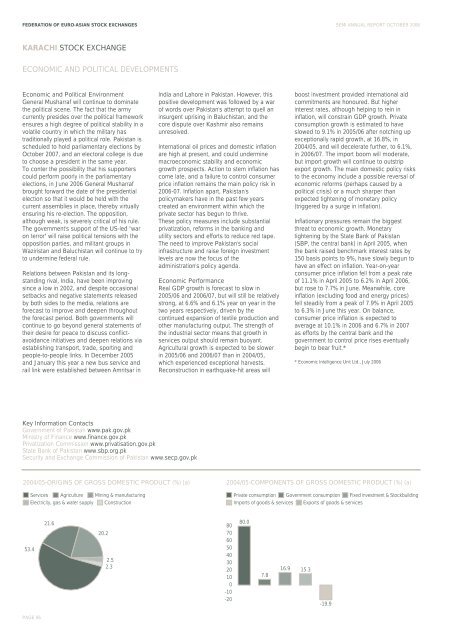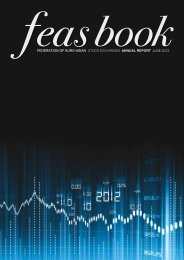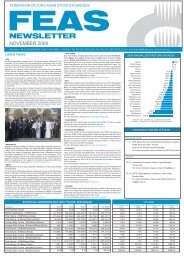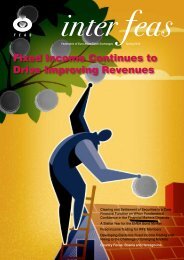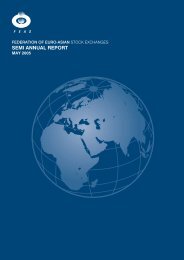Download - FEAS
Download - FEAS
Download - FEAS
You also want an ePaper? Increase the reach of your titles
YUMPU automatically turns print PDFs into web optimized ePapers that Google loves.
FEDERATION OF EURO-ASIAN STOCK EXCHANGES SEMI ANNUAL REPORT OCTOBER 2006<br />
KARACHI STOCK EXCHANGE<br />
ECONOMIC AND POLITICAL DEVELOPMENTS<br />
Economic and Political Environment<br />
General Musharraf will continue to dominate<br />
the political scene. The fact that the army<br />
currently presides over the political framework<br />
ensures a high degree of political stability in a<br />
volatile country in which the military has<br />
traditionally played a political role. Pakistan is<br />
scheduled to hold parliamentary elections by<br />
October 2007, and an electoral college is due<br />
to choose a president in the same year.<br />
To conter the possibility that his supporters<br />
could perform poorly in the parliamentary<br />
elections, in June 2006 General Musharraf<br />
brought forward the date of the presidential<br />
election so that it would be held with the<br />
current assemblies in place, thereby virtually<br />
ensuring his re-election. The opposition,<br />
although weak, is severely critical of his rule.<br />
The government's support of the US-led "war<br />
on terror" will raise political tensions with the<br />
opposition parties, and militant groups in<br />
Waziristan and Baluchistan will continue to try<br />
to undermine federal rule.<br />
Relations between Pakistan and its longstanding<br />
rival, India, have been improving<br />
since a low in 2002, and despite occasional<br />
setbacks and negative statements released<br />
by both sides to the media, relations are<br />
forecast to improve and deepen throughout<br />
the forecast period. Both governments will<br />
continue to go beyond general statements of<br />
their desire for peace to discuss conflictavoidance<br />
initiatives and deepen relations via<br />
establishing transport, trade, sporting and<br />
people-to-people links. In December 2005<br />
and January this year a new bus service and<br />
rail link were established between Amritsar in<br />
India and Lahore in Pakistan. However, this<br />
positive development was followed by a war<br />
of words over Pakistan's attempt to quell an<br />
insurgent uprising in Baluchistan, and the<br />
core dispute over Kashmir also remains<br />
unresolved.<br />
International oil prices and domestic inflation<br />
are high at present, and could undermine<br />
macroeconomic stability and economic<br />
growth prospects. Action to stem inflation has<br />
come late, and a failure to control consumer<br />
price inflation remains the main policy risk in<br />
2006-07. Inflation apart, Pakistan's<br />
policymakers have in the past few years<br />
created an environment within which the<br />
private sector has begun to thrive.<br />
These policy measures include substantial<br />
privatization, reforms in the banking and<br />
utility sectors and efforts to reduce red tape.<br />
The need to improve Pakistan's social<br />
infrastructure and raise foreign investment<br />
levels are now the focus of the<br />
administration's policy agenda.<br />
Economic Performance<br />
Real GDP growth is forecast to slow in<br />
2005/06 and 2006/07, but will still be relatively<br />
strong, at 6.6% and 6.1% year on year in the<br />
two years respectively, driven by the<br />
continued expansion of textile production and<br />
other manufacturing output. The strength of<br />
the industrial sector means that growth in<br />
services output should remain buoyant.<br />
Agricultural growth is expected to be slower<br />
in 2005/06 and 2006/07 than in 2004/05,<br />
which experienced exceptional harvests.<br />
Reconstruction in earthquake-hit areas will<br />
boost investment provided international aid<br />
commitments are honoured. But higher<br />
interest rates, although helping to rein in<br />
inflation, will constrain GDP growth. Private<br />
consumption growth is estimated to have<br />
slowed to 9.1% in 2005/06 after notching up<br />
exceptionally rapid growth, at 16.8%, in<br />
2004/05, and will decelerate further, to 6.1%,<br />
in 2006/07. The import boom will moderate,<br />
but import growth will continue to outstrip<br />
export growth. The main domestic policy risks<br />
to the economy include a possible reversal of<br />
economic reforms (perhaps caused by a<br />
political crisis) or a much sharper than<br />
expected tightening of monetary policy<br />
(triggered by a surge in inflation).<br />
Inflationary pressures remain the biggest<br />
threat to economic growth. Monetary<br />
tightening by the State Bank of Pakistan<br />
(SBP, the central bank) in April 2005, when<br />
the bank raised benchmark interest rates by<br />
150 basis points to 9%, have slowly begun to<br />
have an effect on inflation. Year-on-year<br />
consumer price inflation fell from a peak rate<br />
of 11.1% in April 2005 to 6.2% in April 2006,<br />
but rose to 7.7% in June. Meanwhile, core<br />
inflation (excluding food and energy prices)<br />
fell steadily from a peak of 7.9% in April 2005<br />
to 6.3% in June this year. On balance,<br />
consumer price inflation is expected to<br />
average at 10.1% in 2006 and 6.7% in 2007<br />
as efforts by the central bank and the<br />
government to control price rises eventually<br />
begin to bear fruit.*<br />
* Economic Intelligence Unit Ltd., July 2006<br />
Key Information Contacts<br />
Government of Pakistan www.pak.gov.pk<br />
Ministry of Finance www.finance.gov.pk<br />
Privatization Commission www.privatisation.gov.pk<br />
State Bank of Pakistan www.sbp.org.pk<br />
Security and Exchange Commission of Pakistan www.secp.gov.pk<br />
2004/05-ORIGINS OF GROSS DOMESTIC PRODUCT (%) (a)<br />
Services Agriculture Mining & manufacturing<br />
Electricity, gas & water supply Construction<br />
2004/05-COMPONENTS OF GROSS DOMESTIC PRODUCT (%) (a)<br />
Private consumption Government consumption Fixed investment & Stockbuilding<br />
Imports of goods & services Exports of goods & services<br />
53.4<br />
21.6<br />
20.2<br />
2.5<br />
2.3<br />
80<br />
70<br />
60<br />
50<br />
40<br />
30<br />
20<br />
10<br />
0<br />
-10<br />
-20<br />
80.0<br />
7.8<br />
16.9 15.3<br />
-19.9<br />
PAGE 86


